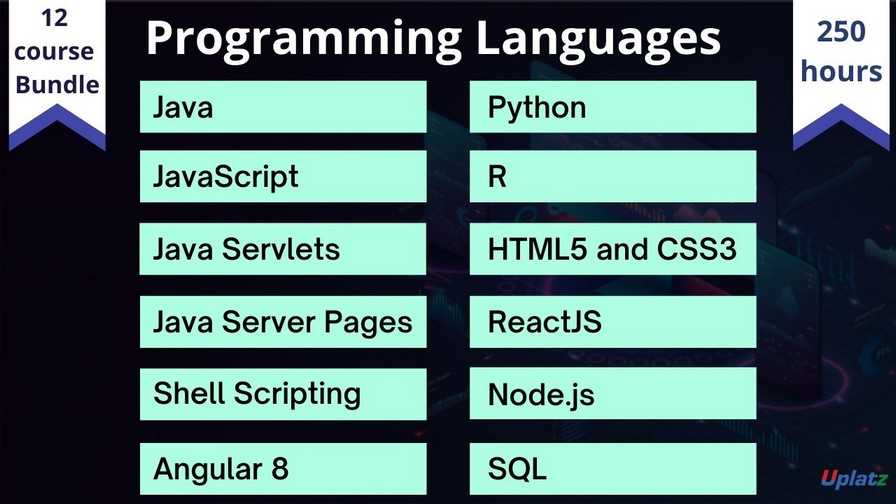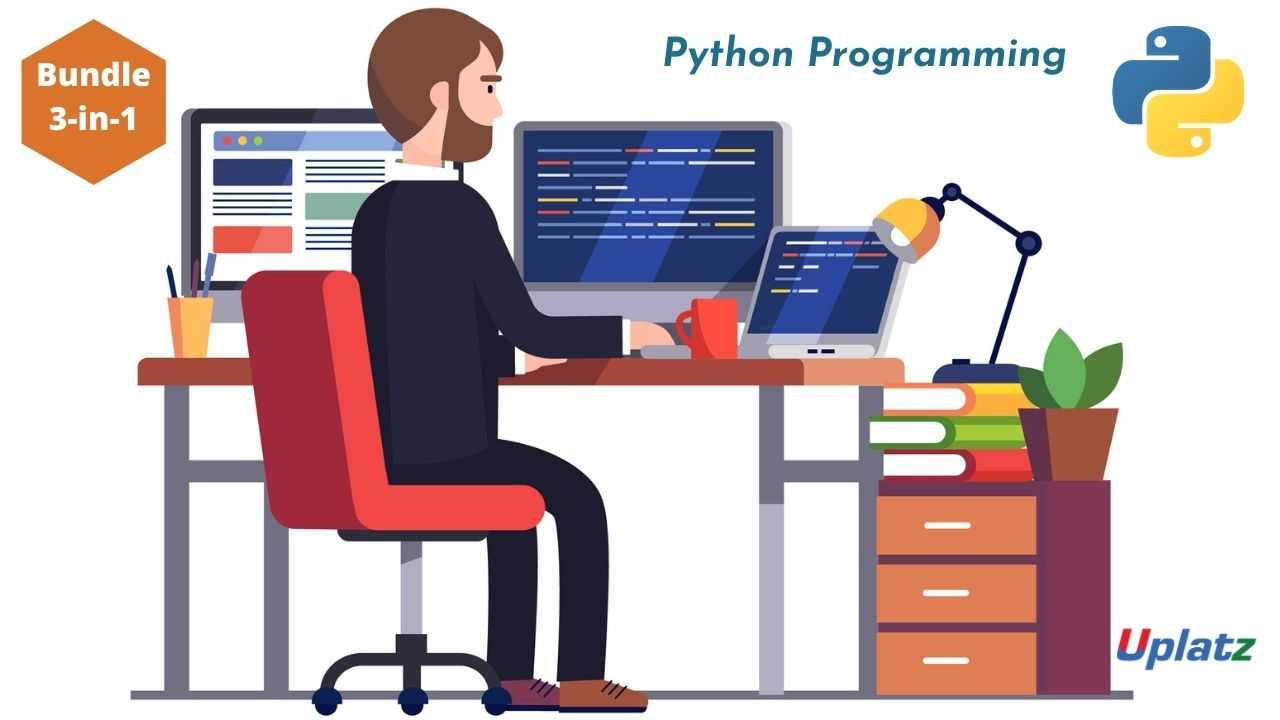Bundle Multi (2-in-1) - Microsoft Project
Learn how to analyse, visualize and store data with Power BI. View Course Curriculum
Price Match Guarantee
Full Lifetime Access
Access on any Device
Technical Support
Secure Checkout
Course Completion Certificate
View Course Curriculum
Price Match Guarantee
Full Lifetime Access
Access on any Device
Technical Support
Secure Checkout
Course Completion Certificate
 58% Started a new career
BUY THIS COURSE (
58% Started a new career
BUY THIS COURSE (GBP 22 GBP 49 )-
 79% Got a pay increase and promotion
79% Got a pay increase and promotion
Students also bought -
-

- Bundle Course - Data Analysis with MS Excel & Google Sheets
- 10 Hours
- GBP 22
- 3775 Learners
-

- Bundle Course - Programming Languages
- 250 Hours
- GBP 22
- 2454 Learners
-

- Bundle Multi (4-in-1) - Python Programming
- 120 Hours
- GBP 22
- 3779 Learners

This is the Bundle Multi (2 in1) – Microsoft Project Course by Uplatz consisting of self-paced training (pre-recorded videos) on the following modules:
1. Microsoft Project (Beginner)
2. Microsoft Project (Basic to Advanced)
Microsoft Project is a project management program. It is used across many businesses. Users can make project plans, record tasks, resources and costs, and produce professional and efficient reports.
Microsoft Project is the factual standard project management tool, providing everything you need to build up plans, assign resources to tasks, track progress, manage budgets and evaluate workloads. It is a software program specifically designed to assist project managers in reaching project goals and objectives, as well as plan elements such as resource allocation, job distribution and input integration.
Dealing with large projects can be daunting through the whole project lifecycle. In this expert-level Microsoft Project training you will get knowledge of defining and creating a project, resources, assignments, as well as tracking and reporting.
Uplatz’s Microsoft Project Bundle Multi (2 in1) Course offers an in-depth explanation of this extensively used project management package from beginner to advanced level. This Microsoft Project training course will teach you how to make the most of planning and managing projects using Microsoft Project, building on your existing skills and teaching you to make the most of this powerful project management software.
By the end of this course, you will have the skills and knowledge of Microsoft Project 2019 needed to use the agile capabilities in the subscription version of Project, and how to print and communicate different aspects of the project plan using custom and pre-defined reports.
Course/Topic 1 - Microsoft Project - all topics
-
Lecture 1 - Getting Started with Microsoft Project
-
Lecture 2 - Backstage
-
Lecture 3 - Modifying Project Information
-
Lecture 4 - Views and Tables
-
Lecture 5 - Preparation
-
Lecture 6 - Tasks
-
Lecture 7 - Task Notes
-
Lecture 8 - Work Resources
-
Lecture 9 - Material and Cost Resources
-
10 - Calendar Work Resource
Course/Topic 2 - Microsoft Project (basic to advanced) - all lectures
-
Lecture 1 - Overview of Microsoft Project
-
Lecture 2 - The Stage
-
Lecture 3 - The Back Stage
-
Lecture 4 - Views and Tables in MSP
-
Lecture 5 - Project Initiation - part 1
-
Lecture 6 - Project Initiation - part 2
-
Lecture 7 - Tasks and Milestones
-
Lecture 8 - Linking Tasks
-
Lecture 9 - More on Linking Tasks
-
Lecture 10 - Creating Resources
-
Lecture 11 - Creating Resources - advanced
-
Lecture 12 - Assigning Resources
-
Lecture 13 - Applying Cost Tables
-
Lecture 14 - Units Work Duration
-
Lecture 15 - Handy Features - revised
-
Lecture 16 - Critical Path Identification
-
Lecture 17 - Resource Leveling
-
Lecture 18 - Baselining
-
Lecture 19 - Updating Project - part 1
-
Lecture 20 - Updating Project - part 2
-
Lecture 21 - Updating Project - part 3
-
Lecture 22 - Monitoring
-
Lecture 23 - Controlling - part 1
-
Lecture 24 - Controlling - part 2
-
Lecture 25 - Reports Pack
-
Lecture 26 - Support EVM
You will learn;
a).How to preparing Data for analysis
b).How to key Metrics
c).How to comparison Analysis
d).How to trend Analysis
e).How to ranking Analysis
f).About Interactive Dashboard
g).About contribution Analysis
This course provides a comprehensive introduction to Microsoft Project, focusing on project management principles and practical application of the software. Participants will learn how to plan, execute, and manage projects effectively using Microsoft Project.
Part 1: Introduction to Project Management
Week 1: Fundamentals of Project Management
a) Overview of project management concepts and methodologies
b)Understanding project life cycles: Initiation, Planning, Execution, Monitoring, and Closing
c) Roles and responsibilities of a project manager
d) Key project management terms and terminology
Week 2: Introduction to Microsoft Project
a) Overview of Microsoft Project and its interface
b) Key features and tools in Microsoft Project
c) Setting up a new project file
d) Hands-on exercise: Navigating the Microsoft Project interface
Week 3: Defining Project Goals and Objectives
a) Developing a project charter and scope statement
b) Identifying project stakeholders and their needs
c) Defining project goals, objectives, and deliverables
d) Hands-on exercise: Creating a project charter in Microsoft Project
Week 4: Creating a Work Breakdown Structure (WBS)
a) Understanding the importance of WBS in project planning
b) Techniques for breaking down project tasks
c) Creating and organizing tasks in Microsoft Project
d) Hands-on exercise: Building a WBS for a sample project
Part 2: Planning and Scheduling
Week 5: Task Scheduling and Dependencies
a) Defining task durations and dependencies (finish-to-start, start-to-start, etc.)
b) Creating task relationships and constraints
c) Utilizing the Gantt chart for visual scheduling
d) Hands-on exercise: Scheduling tasks and setting dependencies
Week 6: Resource Management
a) Identifying project resources: human, material, and equipment
b) Assigning resources to tasks and managing workloads
c) Understanding resource leveling and allocation
d) Hands-on exercise: Managing resources in Microsoft Project
Week 7: Budgeting and Cost Management
a) Estimating project costs and creating a budget
b) Tracking expenses and managing financial resources
c) Setting up cost resources and analyzing variances
d) Hands-on exercise: Creating a budget in Microsoft Project
Week 8: Monitoring and Controlling Projects
a) Overview of project monitoring techniques
b) Key performance indicators (KPIs) for project success
c) Using baseline and variance analysis in Microsoft Project
d) Hands-on exercise: Tracking project progress and making adjustments
Part 3: Advanced Topics and Project Closure
Week 9: Advanced Features in Microsoft Project
a) Utilizing reports and dashboards for project insights
b) Customizing views and filters for better data management
c) Integrating Microsoft Project with other tools (e.g., Excel, SharePoint)
d) Hands-on exercise: Creating custom reports in Microsoft Project
Week 10: Project Closure and Lessons Learned
a) Closing a project: final deliverables, documentation, and approvals
b) Conducting post-project evaluations and lessons learned sessions
c) Best practices for transitioning projects to ongoing operations
d) Hands-on exercise: Documenting project closure in Microsoft Project
Recommended Resources:
Textbooks:
1) "Microsoft Project 2019 Step by Step" by Cindy Lewis
2) "Project Management for the Unofficial Project Manager" by Kory Kogon, Suzette Blakemore, and James Wood
Online Resources:
1) Microsoft Learn for Project
2) Project Management Institute (PMI) resources and guidelines
Tools:
1) Microsoft Project for hands-on practice
Assessment:
1) Weekly quizzes and assignments
2) Mid-term project focusing on project planning and scheduling
3) Final capstone project showcasing complete project management from initiation to closure
The Microsoft Project Certification ensures you know planning, production and measurement techniques needed to stand out from the competition.
If you need to track dependencies, costs, or more complexity, Project works best. You can use Project desktop or Project for the web. You can see your Planner tasks, both individual and team, in the Tasks app in Teams, and you also see your Project for the web projects in Teams using the Project app in Teams.
There are too many concepts that are practically impossible to master. Even after rigorous training, users do not know how to use the flexibility correctly.
Like any other certification program available, Microsoft project certification involves a number of processes that include training and testing. Certification is only provided after successfully passing exams given by the Microsoft Corporation.
Uplatz online training guarantees the participants to successfully go through the Microsoft Project certification provided by Uplatz. Uplatz provides appropriate teaching and expertise training to equip the participants for implementing the learnt concepts in an organization.
Course Completion Certificate will be awarded by Uplatz upon successful completion of the Microsoft Project online course.
The Microsoft Project draws an average salary of $108,080 per year depending on their knowledge and hands-on experience. The Microsoft Project job roles are in high demand and make a rewarding career.
It depends upon how much you know about project management. If you already know project management, you can probably get a good idea in a day but it might take a week to be proficient. Double that if you do not know project management terms and techniques.
The job of a project manager is to plan and oversee all aspects of a project, and to meet the project's goals on time and within budget. It will require you to organize people, tasks and resources to bring about a successful conclusion.
Note that salaries are generally higher at large companies rather than small ones. Your salary will also differ based on the market you work in.
Q1) Explain what is link task in MS project used for?
Ans-As the name suggests, link task in MS project is used for linking any two tasks in a project.
Q2) Mention where is “summary task” in MS project?
Ans-Summary task is helpful in estimating the task period and the length in project, and organizing the task in order. You can find “summary task” under main menu -> Insert -> Summary
Q3) List out the categories of tasks used in MS Project?
Ans-There are major four types of tasks:
a) Summary tasks: It consists of subtasks and their related properties
b) Subtasks: It is a smaller task that are part of a summary task
c) Recurring tasks: These are the tasks that falls at regular intervals
d) Milestones: These are the prime priority task that are adjusted to zero duration and are like short-term goals in the project
Q4) Mention what are the new features available in MS project 2013?
Ans-
a) Improved reporting tools: MS project 2013 offers advanced reporting tools and easy accountability for organizations
b) Office 365 Integration: Easy integration of office 365 to the MS project data
c) New Project Templates: The new MS project provides project templates that can be compliance to your requirement like marketing, construction, business, software development plan, etc.
d) Better Presentation Tools: The timeline view gives better view of the progress of your project and helps to schedule your project accordingly
e) Task Path: This feature can be handy for a project manager handling large and complex schedules. It allows the user to see the path for a specific task including Successors, Driven successors, Predecessors and Driving Predecessors.
Q5) Explain what is a constraint in MS project? What are the types of constraint available in MS project 2013?
Ans-In MS project, constraint is used for scheduling the task and setting a due date for the task. The types of constraint available in MS project are
a) As soon as possible
b) As late as possible
c) Must start on
d) Must finish on
e) Finish no later than
f) Start no later than
g) Start no earlier than
h) Finish no earlier than
Q6) Mention how to set a deadline in MS Project?
Ans-To set a deadline in MS project
a) Double-click a task -> it will open a task information dialog box
b) Now, click on the advanced tab
c) Then click on the arrow in the deadline field to show the calendar and then choose a date
d) Now save this by clicking on the save button
Q7) Explain how you can move tasks in Project 2013?
Ans-You can move tasks in MS project 2013 by two techniques
a) Move the task with drag and drop method
b) Move the task with the cut and paste method
Q8) Explain how you can remove resource from your project?
Ans-To remove the resource from your project, first filter the task list to view only the tasks to which the resource is allocated, and then you can edit or change each task to replace that resource.
a) Choose a task-oriented view like Gantt chart and hide the summary tasks, this list will show only work tasks and milestones
b) Under View tab’s data section, click on the filter drop-down list and then select “Using Resource.”
c) In the “show tasks using” drop-down list, select the resource and delete it that you don’t want and then click ok
d) To replace the resource, select “Assign Resources” under resource tab’s assignment section. Select the task from the table you want to re-assign, and then, in the Assign resource dialog box, choose the resource you want to replace and click replace
e) Click the format tab, and turn the checkbox back on for “Show Summary Tasks.”
f) Click resource sheet in the view tab’s resource view section and now you can delete the resource
Q9) Mention what is the characteristics of Gantt Chart Basics?
Ans-
a) In Gantt chart, each task is displayed by one row
b) Dates are displayed in incremental order like days, weeks or months as per the total length of the project
c) For each task expected, time is displayed by a horizontal bar whose left end indicates the estimated beginning of the task and right end indicates the estimated completion date
d) Task may run parallel, sequentially or overlapping
e) The chart is represented in the bar formation to a length proportional to the fraction of the work that has been completed
f) On the left of the line, you will see the completed tasks
g) Future tasks line lies to the right of the line
h) Current task are cross the line and are behind schedule when filled in section is on the left of the line and ahead of schedule when it is right of the line
Q10) Explain what is the use of work contour in MS Project? What are the different types of contour you use in MS Project?
Ans-In MS project work, contour displays the distribution of working hours over the duration of the task. The graph will show the peak according the work distribution over the week.
a) Flat: Such contour signifies an even distribution of work
b) Back-loaded: It will show the peak activity at the end of the project
c) Front-loaded: It will show the peak working activity at the opening of the project
d) Double peak: It will show two major periods of peak activity
e) Early peak: It is same as the front loaded but with the rise to peak activity
f) Late peak: It is same as a back loaded contour with a ramp
g) Bell: It shows a single peak in the central of the project
h) Turtle: A bell with a ramp up and down
Q11) Explain how you can format a Gantt chart on MS Project?
Ans-To format a Gantt chart on MS project
a) First you have to click on Format icon from main menu bar
b) Click customize quick access toolbar, which is last on the corner above menu bar
c) -> click on more components -> select on, comments not in pattern
d) -> click on Gantt Chart Wizard and then click add and ok
e) Once Gantt chart wizard setup, it will open a window that displays various setting like standard, critical path, baseline and other for your Gantt chart. You can select option according to requirement and click next
f) Likewise, you can also set information like resources and dates, resources or dates alone
g) Once you exit wizard, basic formatting like color, font size and appearance can be changed from the main menu ( FORMAT) itself
Q12) Explain how you can link tasks in MS Project 2013?
Ans-You can link or connect any two tasks in a project to manifest their relationship, also referred as dependency. Dependency drives the project schedule and once you change the tasks, every change you make to one alter the task of other, which affects the next and so on. To link the task, you have to
a) Click View -> Gantt Chart
b) Hold down Cntrl and click the two tasks you want to link
c) Click on Task -> Linked the selected tasks
Q13) Mention the types of task links in MS Project 2013?
Ans-There are four types of task links in MS project
a) Finish to start link: In this link the second task cannot be initiated until the first task is completed
b) Start to start link: In this link, the second task can begin at any time after first task is initiated
c) Finish to finish link: In this link, two task does not have to end at the same time, the second task can end anytime after first task is ended
d) Start to finish link: In this link, the second task can’t finish until the first task begins.
Q14) Explain what is resource levelling?
Ans-Resource levelling is the coolest feature given by MS project; these tool schedules work without over allocating work to the employees, especially for those who are indulged in multi-task activities. For example, there is a project A and B and allotted time for this project is 3 and 2 days. When an individual use resource levelling, it schedule the work as first 2 days for the project A and later two days for project B and again on the last day it will return to project A.
Q15) Explain how you can create and code a WBS (Work Breakdown Structure) in MS Project?
a) Inserting Tasks: If you forgot to insert task in the list you can add by clicking the place whee you want to add a task and go to “Insert>New” task or press “insert.”
b) Outlining Structure: You will be creating an outline of the project by assigning the project name. In respect to do that you have to select all deliverables underneath the heading and then click the Indent button. They will all line up, and the deliverable will appear in bold
c) Assign numerical code to tasks: Once you have created a work breakdown, you can assign a numerical code to it. In respect to do that go to “tools” in the task bar. Under “options”, you will see “outline options”, under this you have to click on check box with the option “show outline number”. You will see that the task list will have a numerical code in front of it.
Q16) What should you be aware of before importing excel file to MS Project?
Ans-Before you import excel file, you should be aware of following things
a) Make sure which excel file fields will be mapped to which MS project
b) Not necessary that all fields in the excel should be imported to MS project, you have the opportunity to choose the field you wanted to import
c) Make sure that your import file has a column header
d) Blank fields in the excel will be imported as a blank field the project
e) Start and finish date in excel will be imported in the MS project start and finish field as start no earlier than constraints for the tasks
f) If the map has to imported then, it should in Global.mpt file format on your machine, if it is not in that format then import wizard will nod show the map as selection choice.
Q17) Explain the path for importing excel into the MS Project 2013?
Ans-Path for importing the file into MS project:
File -> Open -> Files of type -> Excel workbook -> browse the file and select the file -> Now click on Open -> Wizard will start -> Click Next
At the end of the run wizard, it will ask how you want to import the file
a) As a new project
b) Append the data to the active project
c) Merge the data into the active project
After selecting any of the above options, you can click next to finish importing excel file to MS project.
Q18) Explain how you can compare budget resource values in MS Project?
Ans-
a) Go to Resource Usage view ( View -> Resource Usage)
b) Add budget cost, Work, budget work and Cost columns to the table if they are not there already
c) Tap on the drop down arrow to the right of the Resource Name column heading and then choose “Group by” -> Custom group, in order to group the resource by custom resource test field
d) Tap on the down arrow in the Field Name cell in the Group By row section, after that in the drop down list of resource fields, select the name of the custom text field for your budget categories and then click apply
e) Now in the group summary rows, compare the budget get cost or budget work values to the cost or work values simultaneously
f) To dismantle the group, you can choose NO groups by clicking down arrow to the right of the Resource Name column heading
Q19) Explain what are the setting you have to insert while entering Project Information into Project 2013?
Ans-
To enter project information into project 2013, it includes information like
a) Start and Finish Date: For a project that is scheduled forward from the start date, enter only the start date, while enter the finish date if you like to schedule backward from finish date
b) Schedule From: You can select the finish date or start date whichever way you want to schedule your task
c) Current Date: By default this setting matches the computer clock settings; however it can be configured according to your requirement
d) Status Date: To track the progress on the project you can the current date status. This will show the status of the project as of the current moment
e) Calendar: From this drop-down list you can choose the base calendar template to use for the project calendar
f) Priority: By using this field you can prioritize your work and decide which work has to be delayed and which has to be done immediately
Q20) Explain how to set work time exception in Project 2013?
Ans-To alter the available working hours in Project 2013 for a particular day, you have to change the work time exception settings. In order to do that
a) Select the project and change the working time
b) On the calendar choose the day you want to change
c) Click the exception tab to display it, it will show a column with the name cell in a blank row, type a name for the exception and press enter
d) Tap the exception name you entered in step 3 and then click the details button. It will open a detail dialog box for this exception. Where you will make the setting according to your requirement like working time, recurrent pattern and range of recurrence.









